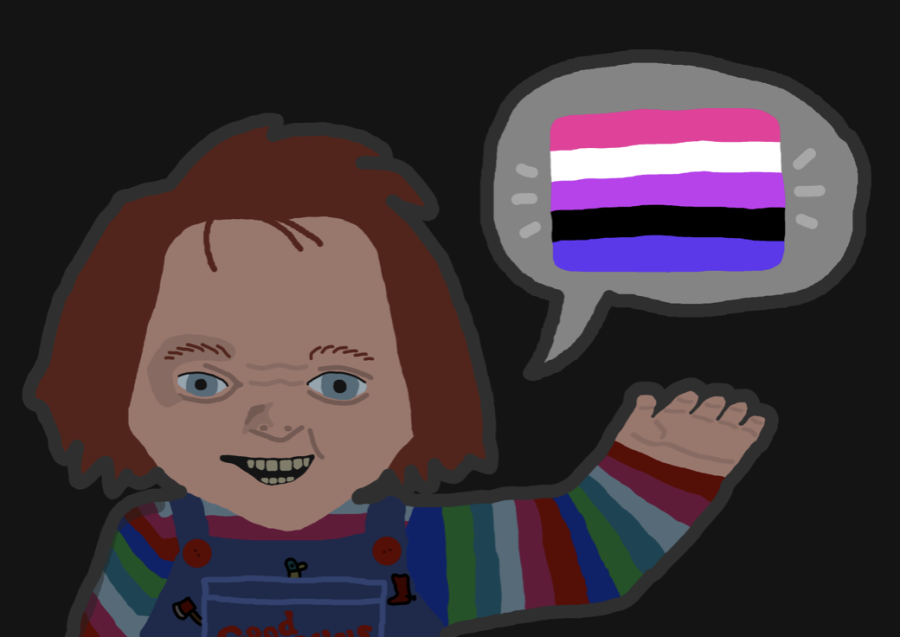No need to fear! Queer horror is here!
LGBTQ horror to watch
The horror genre is one that means a lot to me, even though I didn’t dare to watch a horror film until I was 14. Now I’m an adrenaline junkie, rummaging through slashers, haunted house movies, South Korean cinema and the New French Extremity movement in the search of something terrifying. While I would normally love to just recommend a few of the over 200 horror films I have watched throughout my life, I think it would be more interesting to get a little more specific and talk about some examples of queer horror. As an openly queer man, I have been pleasantly surprised to see the horror genre embrace queerness a lot more openly in recent years, while also having some subtext in earlier works as well. So with that, here are some queer horror films that should be watched this Halloween.
First on the list is Leigh Janiak’s “Fear Street” trilogy, all of which were released on Netflix in July of 2021. The overarching story takes place in 1994 and follows a group of teenagers in the fictional town of Shadyside who work to break the centuries-old, violent curse. Each film is a (mostly) campy homage to different franchises and genres; “Part One: 1994” borrows from Wes Craven’s “Scream”, “Part Two: 1978” is very reminiscent of the “Friday the 13th” series and “Part Three: 1666” pays homage to Terrence Malick’s “The New World” (which isn’t a horror film, but it does still define the tone of the trilogy capper). The film’s primary characters, Deena and Sam, are a lesbian couple who struggle with the homophobic attitude of their town. The characters are realistic, and the writing and acting make them feel endearing. The film does a great job of helping the audience buy into this romance, and I really wanted them to succeed by the end of the first movie.
Next on the list is Robert Eggers’ “The Lighthouse.” The film follows two lighthouse keepers (played by Robert Pattinson and Willem Dafoe) as they start to lose their sanity due to isolation. It’s a mix of a Lovecraftian and psychosexual horror, the latter of which contributes to the film’s queer themes. The film is incredibly dense and takes inspiration from Edgar Allan Poe, Sigmund Freud, Greek mythology and Carl Jung (just to name a few), so even though I’ve watched this film three times, I still don’t understand everything that this movie is trying to say. However, I believe that the film partially works as a statement on internalized homophobia and a story about a man coming to terms with his own sexuality. Pattinson’s character has numerous scenes where he is biding his time by pleasuring himself while holding a sculpture of a mermaid. Throughout these scenes, his facial expressions become more pained over time, as if to imply that he’s trying to be aroused by the female sculpture. This can also be interpreted as the character’s shame over this sexual act, but we later see him and Dafoe’s characters kiss. Throughout the film, their interactions can also be read as them alternating between dominant and submissive roles in a sexual relationship. Freelance writer Patrick Caoile has an article on Collider that discusses this film’s queerness in a more detailed way than I can, so I recommend reading that as well.
Both of these examples are more recent and not the most popular horror films out there. However, people might not have recognized the inclusivity and subtext present in the popular “Child’s Play” / “Chucky” franchise (aside from the 2019 reboot, which won’t be acknowledged). All of the seven films (to date) were written by Don Mancini, with him directing every movie starting from 2004’s “Seed of Chucky.” He is also the creator and showrunner of the TV series continuation “Chucky.” As an openly gay man, Mancini’s sexuality informs quite a bit of the franchise. He has even described Jake, the protagonist of the sequel TV series “Chucky,” as a stand-in for himself, while also characterizing the first season as semi-autobiographical. Jake is a 14-year-old boy who struggles with his homosexuality while his father is in denial of his son’s identity. In one particularly disturbing scene, Jake calls himself a “f**,” resulting in his father punching him in the face; this interaction that Mancini said was directly based on an experience with his own father. The rest of the season sees Jake as he falls in love with a fellow classmate and is nearly manipulated by Chucky to kill his homophobic bullies. We also see Chucky kill Jake’s dad due to his homophobia, which is honestly pretty funny when remembering the disturbing things that he’s done in previous films; killing innocent people and crippling children is totally fine, but homophobia is where he draws the line. I can’t help it, this is just really funny to me.
This wasn’t even the first time Mancini embraced these themes. In the early 2000s, he cast queer icon Jennifer Tilly (“Bound”) as Chucky’s ex-girlfriend Tiffany in “Bride of Chucky.” The next film, “Seed of Chucky,” is probably the queerest film in the series. The meta-horror film has a bit of homoeroticism with Tiffany becoming infatuated with actress Jennifer Tilly (in this film, she plays Tiffany while also playing Jennifer Tilly, who plays Tiffany in movies being made in the universe of this franchise). However, the main reason people remember this film is Glen/Glenda, who is Chucky and Tiffany’s gender-fluid kid. Keep in mind that this film came out back in 2004, so the fact that a mainstream horror film has a gender-queer main character is surprisingly progressive, especially during a time when films like “Hostel” and “Cabin Fever” casually used the f-slur as “comedy.” Not only that but Glen/Glenda is a solidly written and entertaining character, which is aided by Billy Boyd’s voice acting. Granted, the casting of a cisgender man as a gender-queer character hasn’t aged well, but the fact that the character was in the film at all is already a groundbreaking work of representation in horror. Plus, this has been rectified with the casting of nonbinary actor Lachlan Watson as both Glen and Glenda in the second season of “Chucky.”
There are many other queer horror films that deserve to be watched and cherished by the massive horror fanbase. But these are a few that I personally love and recommend for people to watch during this scary time. Happy Halloween!
RATINGS:
“Fear Street” Trilogy: 7/10
“The Lighthouse”: 10/10
“Child’s Play” (1988): 7/10
“Child’s Play 2” (1990): 7/10
“Cult of Chucky: 7/10
“Chucky” – Season 1: 7.8/10

Hello! My name is Om Dighe (he/they), and I am an Arts Columnist. I am a senior from Spring, TX, majoring in Communications and double minoring in Film...

I'm Tony Rodriguez! I'm a junior from San Antonio, TX, majoring in math, and I worked as a copy editor for the Trinitonian about two years ago and am now...





